Prima ballerina, dancer, singer, and actress Liane Haid (1895-2000) was the first film star of Austria. She was the epitome of the Süßes Wiener Mädel (Sweet Viennese Girl), and from the mid-1910s on she made close to a hundred films.
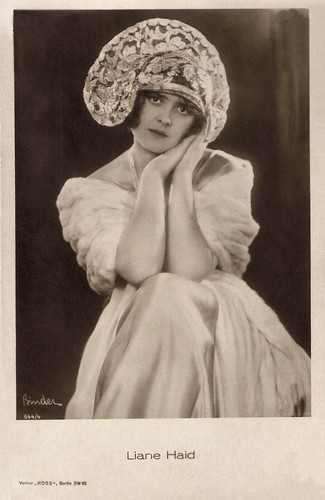
German postcard by Ross Verlag, no. 544/4, 1919-1924. Photo: Alex Binder.
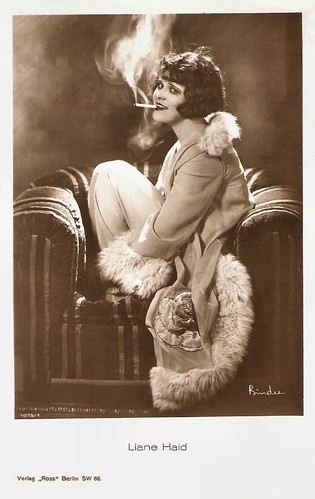
German postcard by Ross Verlag, no. 1075/2, 1927-1928. Photo: Alex Binder.
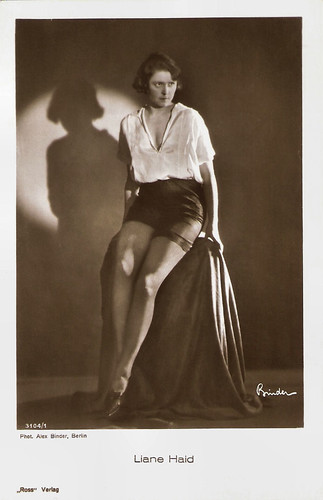
German postcard by Ross Verlag, no. 3104/1, 1928-1929. Photo: Alex Binder, Berlin.
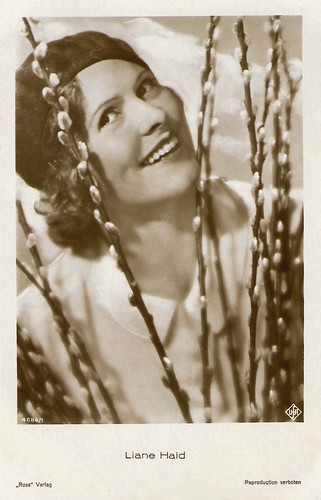
German postcard by Ross Verlag, no. 4886/1, 1929-1930. Photo: Ufa.

German postcard by Ross Verlag, no. 5034/1, 1930-1931. Photo: Manassé, Wien (Vienna).

German postcard by Ross Verlag, no. 5075/2, 1930-1931. Photo: Manassé, Wien.
Juliane Haid was born in Vienna, Austria in 1895. As a child, Liane studied singing and dancing, and she danced at the Viennese Opern Ballet.
Later she worked in Budapest and Vienna as a dancer and in Berlin and Vienna as a stage actress. She had already become a popular opera and operetta singer and dancer before she made her first film appearance.
Her debut was a propaganda film made during the First World War, Mit Herz und Hand fürs Vaterland/With Heart and Hand for the Fatherland (Jacob Fleck, Luise Fleck, 1915).
Most of her early silent films were directed by the husband and wife team Jacob and Luise Fleck for Wiener Kunstfilm. These films include the silent historical film Der Verschwender/The Spendthrift (Jacob Fleck, Luise Fleck, 1917). It is an adaptation of Ferdinand Raimund's play of the same name. Her leading men in these silent films were often Wilhelm Klitsch or Max Neufeld.
After the war, Haid's first husband, Baron Fritz von Haymerle, built her own film studio in Vienna and gave her her own company.
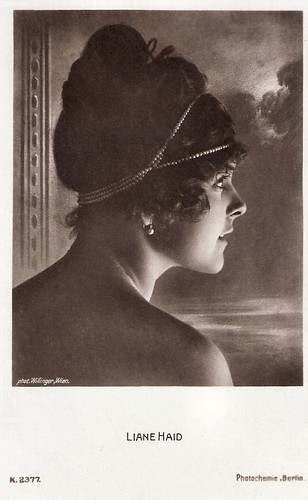
German postcard by Photochemie, Berlin, no. K. 2377. Photo: Willinger, Wien.
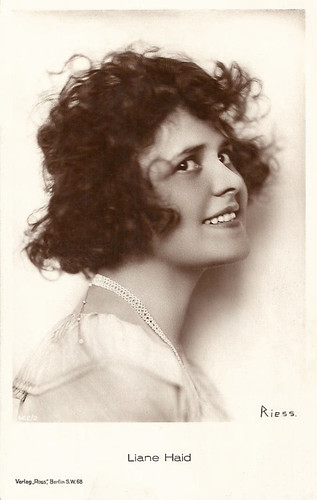
German postcard by Ross Verlag, Berlin, no. 462/2, 1919-1924. Photo: Riess.

German postcard by Ross Verlag, no. 76/1. Photo: Ufa. Publicity still for Die Csardasfürstin/The Csardas Princess (Hanns Schwarz, 1927).

German postcard by Ross Verlag, no. 76/4. Photo: Ufa. Liane Haid in Die Csardasfürstin/The Csardas Princess (Hanns Schwarz, 1927). The young man with the cap is Imre Raday.
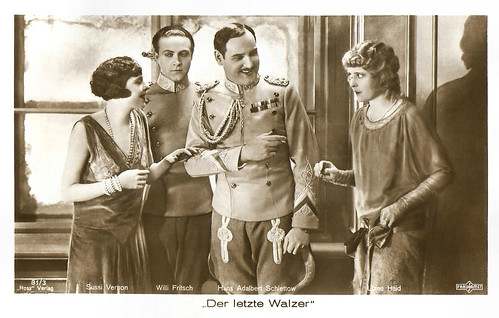
German postcard by Ross Verlag, no. 81/3/3, 1925-1935. Photo: Parufamet. Publicity still for Der Letzte Walzer/The Last Waltz (Arthur Robison, 1927) with Suzy Vernon, Willy Fritsch, Hans Adalbert Schlettow and Liane Haid.
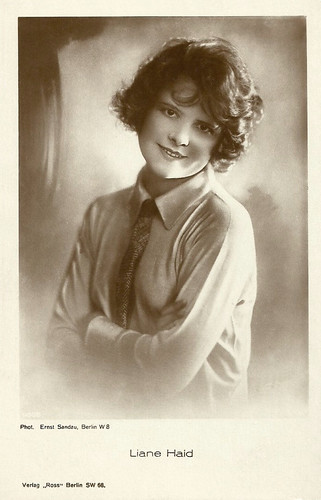
German postcard by Ross Verlag, Berlin, no. 1430/2, 1927-1928. Photo: Ernst Sandau, Berlin.

German postcard by Ross Verlag, Berlin, no. 1732/1, 1927-1928. Photo: Ufa.

German collectors card in the series 'Vom Werden deutscher Filmkunst - Der Tonfilm', album no. 11, picture no. 6, group 44. Photo: Ufa / Ross Verlag. Gustav Fröhlich and Liane Haid in Die unsterbliche Lump/The Immortal Vagabond (Gustav Ucicky, Joe May, 1930).
In the early 1920s, Liane Haid moved to Berlin and had her breakthrough opposite Conrad Veidt in the historical film Lady Hamilton (Richard Oswald, 1921). The film depicts the love affair between the British Admiral Lord Nelson and Lady Emma Hamilton.
Next she played opposite Reinhold Schünzel in Geld auf der Straße/Money on the Street (Reinhold Schünzel, 1922). She also became a popular pin-up.
Haid appeared again opposite Conrad Veidt in the historical film Lucrezia Borgia/Bride of Vengeance (Richard Oswald, 1922) and the drama Die Brüder Schellenberg/The Brothers Schellenberg (Karl Grune, 1926) with Lil Dagover. The first portrayed the life of the Renaissance Italian aristocrat Lucrezia Borgia (1480-1519).
Also popular were the operettas Im weißen Rößl/The White Horse Inn (Richard Oswald, 1926) with Max Hansen and based on the play The White Horse Inn by Oskar Blumenthal and Gustav Kadelburg, and Die Csardasfürstin/The Csardas Princess (Hanns Schwarz, 1927) opposite Hungarian star Imre Ráday. The later was an adaptation of the operetta by Emmerich Kálmán.

German postcard by Verlag Hermann Leiser, Berlin-Wilm., no. 6139.
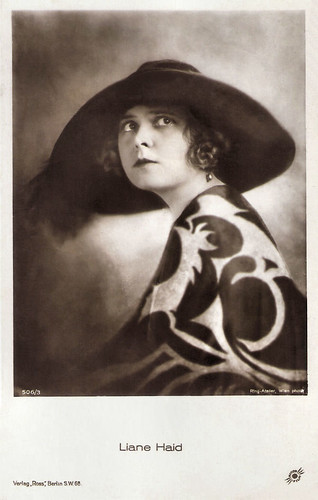
German postcard by Ross Verlag, no. 506/3, 1919-1924. Photo: Ring-Atelier, Wien.
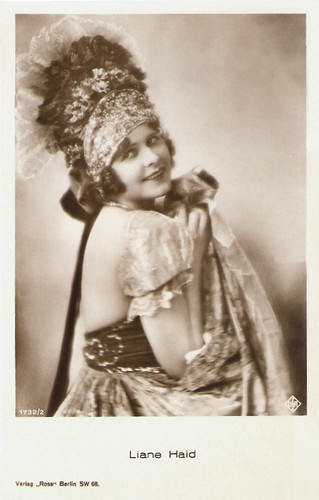
German postcard by Ross Verlag, no. 1732/2, 1927-1928. Photo: Ufa.
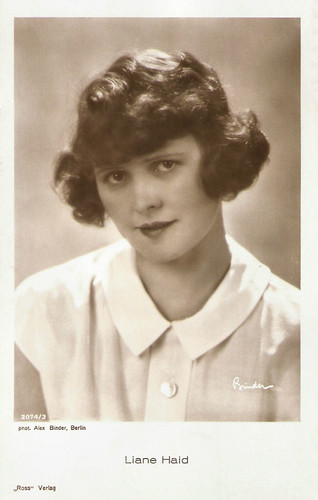
German postcard by Ross Verlag, no. 2074/3, 1927-1928. Photo: Alex Binder.
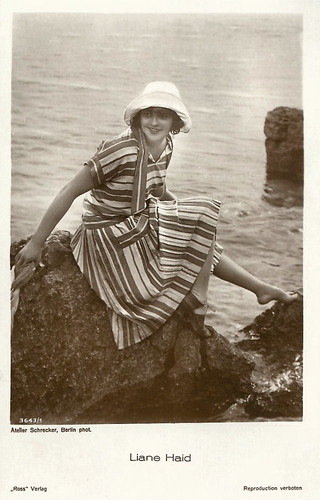
German postcard by Ross Verlag, no. 3643/1, 1928-1929. Photo: Atelier Schrecker, Berlin.
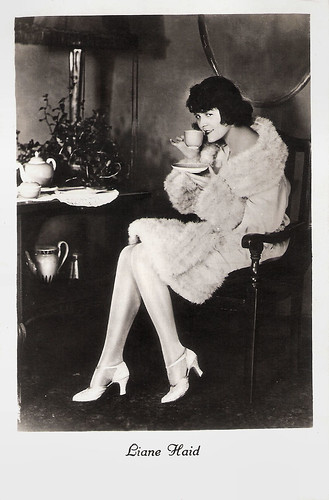
German postcard by H.C. Stöcker, Hannover-Linden, for Bemberg. Caption: "Bemberg-Seide zu tragen ist ein Vergnügen, Liane Haid". (Bemberg silk is a pleasure to wear, Liane Haid).
Liane Haid's switch to sound film went smoothly, because of her training as a singer. Her song Adieu, mein kleiner Gardenoffizier, sung in Géza von Bolváry's popular operetta Das Lied ist aus/The Song Is Over (Géza von Bolváry, 1930), was a huge success at the time.
In the biography Grock (Carl Boese, 1931) she played the wife of the famous clown (played by himself).
For Paramount she appeared in alternate language versions of their productions such as Die Männer um Lucie/The Men Around Lucy (Alexander Korda, 1931), a German version of Laughter (Harry d'Abbadie d'Arrast, 1930) with Nancy Carroll.
Haid became one of the main stars of the German cinema and she appeared opposite leading men like Willi Forst, Georg Alexander, and Gustav Fröhlich. In Ungeküsst soll man nicht schlafen gehn/You should not go to sleep unkissed (E.W. Emo, 1936), she starred opposite Heinz Rühmann, Theo Lingen and Hans Moser.
In these films she was often typecasted as the Süßes Wiener Mädel (sweet Viennese girl).
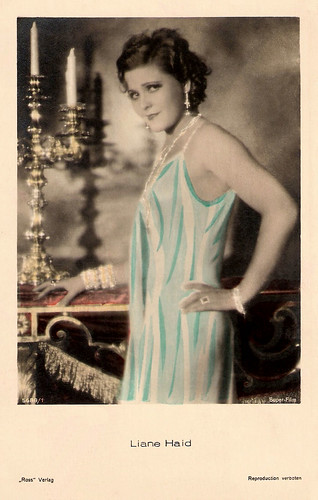
German postcard by Ross Verlag, no. 5689/1, 1930-1931. Photo: Super-Film.
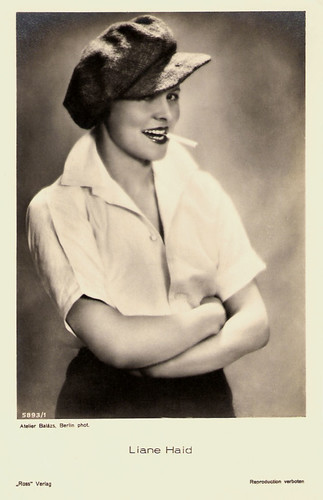
German postcard by Ross Verlag, no. 5893/1, 1930-1931. Photo: Atelier Balázs, Berlin.
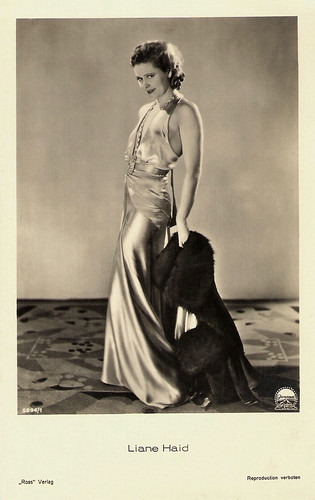
German postcard by Ross Verlag, no. 5994/1, 1930-1931. Photo: Paramount Pictures.
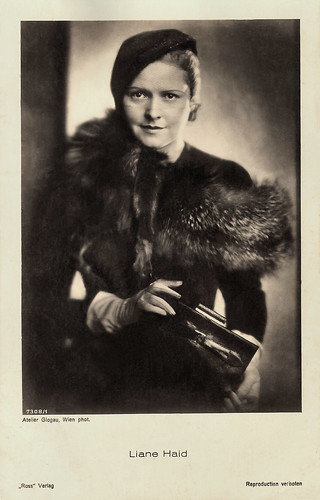
German postcard by Ross Verlag, no. 7308/1, 1932-1933. Photo: Atelier Glogau, Wien.
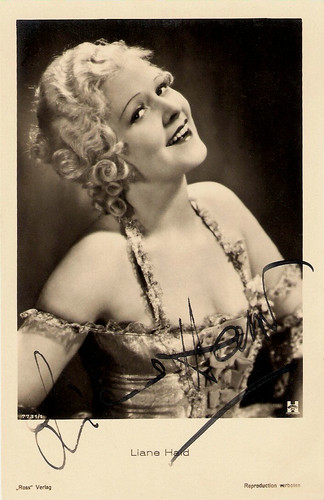
German postcard by Ross Verlag, no. 7731/1, 1932-1933. Photo: H.

German postcard by Ross Verlag, no. 8856/1, 1933-1934. Photo: Atelier Schneider, Berlin.
From the mid-1930s Liane Haid's roles were less frequent. She played a part in the British production Whom the Gods Love: The Original Story of Mozart and His Wife (Basil Dean, 1936). The film was a disaster.
She refused offers from Hollywood and instead focused on her stage career. In 1942 she emigrated with her son to Switzerland. According to Wikipedia she later said about it: "because of the regime, because everything was bombed, and because all the good directors had left".
In Switzerland, she married Dr. Carl Spycher. It was her third marriage. Their son is the jazz musician Pierre Spycher.
Haid made her last film appearance in the Austrian romantic comedy Die Fünf Karnickel/The five rabbits (Kurt Steinwendner, Paul Löwinger, 1953), starring Ingrid Lutz.
Liane Haid died in 2000 in Wabern near Bern, at the age of 105. Her sister Grit Haid was less fortunate. Grit was an equally well-known film actress, who was active in the late 1920s and early 1930s. She suddenly died tragically in a plane accident in 1938.
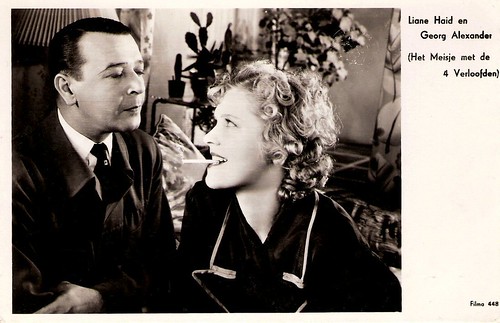
Dutch postcard by Filma, no. 448. Photo: publicity still for Eine Frau wie Du/A Woman Like You (Carl Boese, 1933) with Georg Alexander.
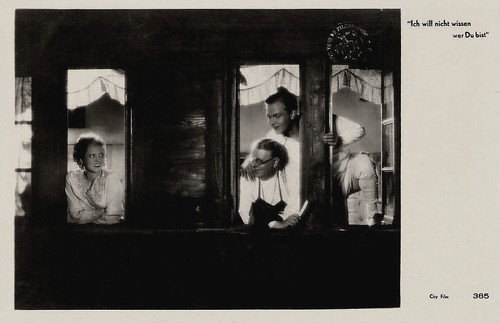
Dutch postcard by JosPe, Arnhem for City Film, no. 385. Photo: publicity still for Ich will nicht wissen, wer du bist/I don't Wanna Know Who You Are (Géza von Bolváry, 1932) with Gustav Fröhlich and Szöke Szakáll.
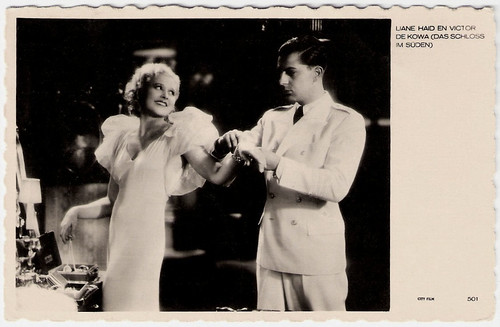
Dutch postcard by City Film, no. 501. Photo: publicity still for Das Schloß im Süden/The Castle in the South (Géza von Bolváry, 1933) with Viktor de Kowa.

German postcard by Ross Verlag, no. 7847/1, 1932-1933. Photo: Ufa. Publicity still for Der Stern von Valencia/The Star of Valencia (Alfred Zeisler, 1933) with Paul Westermeier.

German postcard by Ross Verlag, no. 8256/1, 1933-1934. Photo: Ideal-Film, Berlin. Ralph A. Roberts and Liane Haid in for Keine Angst vor Liebe/Don't Be Afraid of Love (Hans Steinhoff, 1933).

German postcard by Ross Verlag, no. 8258/1, 1933-1934. Photo: Ufa / Cine Allianz. Publicity still for Ihre Durchlaucht, die Verkäuferin/Her Excellency, the Salesgirl (Karl Hartl, 1933) with Willi Forst.
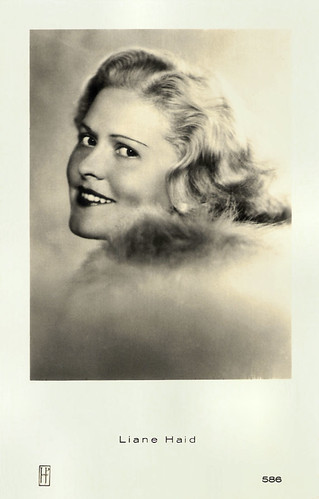
Dutch postcard by JosPe, no. 586.
Sources: Thomas Staedeli (Cyranos), Rudi Polt (IMDb), Wikipedia, and IMDb.
This post was last updated on 11 April 2021.

German postcard by Ross Verlag, no. 544/4, 1919-1924. Photo: Alex Binder.

German postcard by Ross Verlag, no. 1075/2, 1927-1928. Photo: Alex Binder.

German postcard by Ross Verlag, no. 3104/1, 1928-1929. Photo: Alex Binder, Berlin.

German postcard by Ross Verlag, no. 4886/1, 1929-1930. Photo: Ufa.

German postcard by Ross Verlag, no. 5034/1, 1930-1931. Photo: Manassé, Wien (Vienna).

German postcard by Ross Verlag, no. 5075/2, 1930-1931. Photo: Manassé, Wien.
Propaganda film
Juliane Haid was born in Vienna, Austria in 1895. As a child, Liane studied singing and dancing, and she danced at the Viennese Opern Ballet.
Later she worked in Budapest and Vienna as a dancer and in Berlin and Vienna as a stage actress. She had already become a popular opera and operetta singer and dancer before she made her first film appearance.
Her debut was a propaganda film made during the First World War, Mit Herz und Hand fürs Vaterland/With Heart and Hand for the Fatherland (Jacob Fleck, Luise Fleck, 1915).
Most of her early silent films were directed by the husband and wife team Jacob and Luise Fleck for Wiener Kunstfilm. These films include the silent historical film Der Verschwender/The Spendthrift (Jacob Fleck, Luise Fleck, 1917). It is an adaptation of Ferdinand Raimund's play of the same name. Her leading men in these silent films were often Wilhelm Klitsch or Max Neufeld.
After the war, Haid's first husband, Baron Fritz von Haymerle, built her own film studio in Vienna and gave her her own company.

German postcard by Photochemie, Berlin, no. K. 2377. Photo: Willinger, Wien.

German postcard by Ross Verlag, Berlin, no. 462/2, 1919-1924. Photo: Riess.

German postcard by Ross Verlag, no. 76/1. Photo: Ufa. Publicity still for Die Csardasfürstin/The Csardas Princess (Hanns Schwarz, 1927).

German postcard by Ross Verlag, no. 76/4. Photo: Ufa. Liane Haid in Die Csardasfürstin/The Csardas Princess (Hanns Schwarz, 1927). The young man with the cap is Imre Raday.

German postcard by Ross Verlag, no. 81/3/3, 1925-1935. Photo: Parufamet. Publicity still for Der Letzte Walzer/The Last Waltz (Arthur Robison, 1927) with Suzy Vernon, Willy Fritsch, Hans Adalbert Schlettow and Liane Haid.

German postcard by Ross Verlag, Berlin, no. 1430/2, 1927-1928. Photo: Ernst Sandau, Berlin.

German postcard by Ross Verlag, Berlin, no. 1732/1, 1927-1928. Photo: Ufa.

German collectors card in the series 'Vom Werden deutscher Filmkunst - Der Tonfilm', album no. 11, picture no. 6, group 44. Photo: Ufa / Ross Verlag. Gustav Fröhlich and Liane Haid in Die unsterbliche Lump/The Immortal Vagabond (Gustav Ucicky, Joe May, 1930).
Popular Pin-up
In the early 1920s, Liane Haid moved to Berlin and had her breakthrough opposite Conrad Veidt in the historical film Lady Hamilton (Richard Oswald, 1921). The film depicts the love affair between the British Admiral Lord Nelson and Lady Emma Hamilton.
Next she played opposite Reinhold Schünzel in Geld auf der Straße/Money on the Street (Reinhold Schünzel, 1922). She also became a popular pin-up.
Haid appeared again opposite Conrad Veidt in the historical film Lucrezia Borgia/Bride of Vengeance (Richard Oswald, 1922) and the drama Die Brüder Schellenberg/The Brothers Schellenberg (Karl Grune, 1926) with Lil Dagover. The first portrayed the life of the Renaissance Italian aristocrat Lucrezia Borgia (1480-1519).
Also popular were the operettas Im weißen Rößl/The White Horse Inn (Richard Oswald, 1926) with Max Hansen and based on the play The White Horse Inn by Oskar Blumenthal and Gustav Kadelburg, and Die Csardasfürstin/The Csardas Princess (Hanns Schwarz, 1927) opposite Hungarian star Imre Ráday. The later was an adaptation of the operetta by Emmerich Kálmán.

German postcard by Verlag Hermann Leiser, Berlin-Wilm., no. 6139.

German postcard by Ross Verlag, no. 506/3, 1919-1924. Photo: Ring-Atelier, Wien.

German postcard by Ross Verlag, no. 1732/2, 1927-1928. Photo: Ufa.

German postcard by Ross Verlag, no. 2074/3, 1927-1928. Photo: Alex Binder.

German postcard by Ross Verlag, no. 3643/1, 1928-1929. Photo: Atelier Schrecker, Berlin.

German postcard by H.C. Stöcker, Hannover-Linden, for Bemberg. Caption: "Bemberg-Seide zu tragen ist ein Vergnügen, Liane Haid". (Bemberg silk is a pleasure to wear, Liane Haid).
Smooth Switch
Liane Haid's switch to sound film went smoothly, because of her training as a singer. Her song Adieu, mein kleiner Gardenoffizier, sung in Géza von Bolváry's popular operetta Das Lied ist aus/The Song Is Over (Géza von Bolváry, 1930), was a huge success at the time.
In the biography Grock (Carl Boese, 1931) she played the wife of the famous clown (played by himself).
For Paramount she appeared in alternate language versions of their productions such as Die Männer um Lucie/The Men Around Lucy (Alexander Korda, 1931), a German version of Laughter (Harry d'Abbadie d'Arrast, 1930) with Nancy Carroll.
Haid became one of the main stars of the German cinema and she appeared opposite leading men like Willi Forst, Georg Alexander, and Gustav Fröhlich. In Ungeküsst soll man nicht schlafen gehn/You should not go to sleep unkissed (E.W. Emo, 1936), she starred opposite Heinz Rühmann, Theo Lingen and Hans Moser.
In these films she was often typecasted as the Süßes Wiener Mädel (sweet Viennese girl).

German postcard by Ross Verlag, no. 5689/1, 1930-1931. Photo: Super-Film.

German postcard by Ross Verlag, no. 5893/1, 1930-1931. Photo: Atelier Balázs, Berlin.

German postcard by Ross Verlag, no. 5994/1, 1930-1931. Photo: Paramount Pictures.

German postcard by Ross Verlag, no. 7308/1, 1932-1933. Photo: Atelier Glogau, Wien.

German postcard by Ross Verlag, no. 7731/1, 1932-1933. Photo: H.

German postcard by Ross Verlag, no. 8856/1, 1933-1934. Photo: Atelier Schneider, Berlin.
Switzerland
From the mid-1930s Liane Haid's roles were less frequent. She played a part in the British production Whom the Gods Love: The Original Story of Mozart and His Wife (Basil Dean, 1936). The film was a disaster.
She refused offers from Hollywood and instead focused on her stage career. In 1942 she emigrated with her son to Switzerland. According to Wikipedia she later said about it: "because of the regime, because everything was bombed, and because all the good directors had left".
In Switzerland, she married Dr. Carl Spycher. It was her third marriage. Their son is the jazz musician Pierre Spycher.
Haid made her last film appearance in the Austrian romantic comedy Die Fünf Karnickel/The five rabbits (Kurt Steinwendner, Paul Löwinger, 1953), starring Ingrid Lutz.
Liane Haid died in 2000 in Wabern near Bern, at the age of 105. Her sister Grit Haid was less fortunate. Grit was an equally well-known film actress, who was active in the late 1920s and early 1930s. She suddenly died tragically in a plane accident in 1938.

Dutch postcard by Filma, no. 448. Photo: publicity still for Eine Frau wie Du/A Woman Like You (Carl Boese, 1933) with Georg Alexander.

Dutch postcard by JosPe, Arnhem for City Film, no. 385. Photo: publicity still for Ich will nicht wissen, wer du bist/I don't Wanna Know Who You Are (Géza von Bolváry, 1932) with Gustav Fröhlich and Szöke Szakáll.

Dutch postcard by City Film, no. 501. Photo: publicity still for Das Schloß im Süden/The Castle in the South (Géza von Bolváry, 1933) with Viktor de Kowa.

German postcard by Ross Verlag, no. 7847/1, 1932-1933. Photo: Ufa. Publicity still for Der Stern von Valencia/The Star of Valencia (Alfred Zeisler, 1933) with Paul Westermeier.

German postcard by Ross Verlag, no. 8256/1, 1933-1934. Photo: Ideal-Film, Berlin. Ralph A. Roberts and Liane Haid in for Keine Angst vor Liebe/Don't Be Afraid of Love (Hans Steinhoff, 1933).

German postcard by Ross Verlag, no. 8258/1, 1933-1934. Photo: Ufa / Cine Allianz. Publicity still for Ihre Durchlaucht, die Verkäuferin/Her Excellency, the Salesgirl (Karl Hartl, 1933) with Willi Forst.

Dutch postcard by JosPe, no. 586.
Sources: Thomas Staedeli (Cyranos), Rudi Polt (IMDb), Wikipedia, and IMDb.
This post was last updated on 11 April 2021.
No comments:
Post a Comment